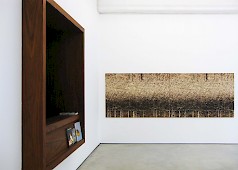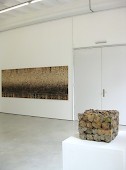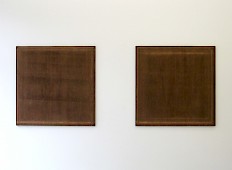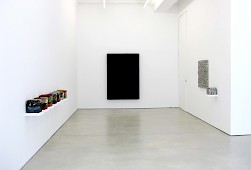Compact
, Berlin






COMPACT is the first solo exhibition of work by the Indian artist Manish Nai (*1980) at Galerie Gebr. Lehmann, Berlin.
COMPACT, an exhibition of pieces produced over the last two years by the Mumbai-based artist Manish Nai, offers a look into an oeuvre characterized by a simple, unadorned materiality. Jute, otherwise known as burlap, could be seen as a foundation, a starting point of sorts for the artistic creations of Nai, who came into contact with the material through his father’s burlap trade. Nai transmits this material, itself a traditional natural product that stands in stark contrast to new synthetic fabrics, into an artistic context.
Utilizing a minimal-abstract formal language, ordinary materials that we encounter daily—burlap and other textiles, newsprint, aluminum—are pressed into blocks, sometimes soaked in binder to lend them solid shape. Materials that invoke a reduced formal language are employed, positioning the artist as a counterpoint to traditional and contemporary Indian visual language, which relies greatly on the narrative and the figurative.
Operating non-figuratively, Nai’s work allows the gaze to focus on the material itself in its play on structures and surfaces. It takes the material for its own “stories,” told through the recycling of worn-out newspapers or fabrics. Precisely this aspect—recycling—is deeply embedded in Indian society, where almost everything gets used, reused and then reused again owing to the fact that the wastage of resources is something most people cannot afford.COMPACT ist die erste Einzelausstellung des indischen Künstlers Manish Nai (*1980) in der Galerie Gebrüder Lehmann, Berlin.
Gezeigt werden Arbeiten der letzten zwei Jahre, welche einen Einblick in das Werk des in Mumbai lebenden Künstlers ermöglichen. Manish Nais Arbeiten zeichnen sich durch eine einfache Materialität aus. Grundlegend und als Ausgangspunkt seines künstlerischen Schaffens steht das Material Jute, mit welchem er durch den Jutehandel seines Vaters in Berührung kam. Dieses traditionelle Naturprodukt steht im Kontrast zu neuen synthetischen Stoffen und wird von Nai in einen künstlerischen Kontext übersetzt.
In minimalistisch abstrakter Formensprache werden einfache, meist alltäglich anzutreffende Materialien wie Jute und andere Textilien, Zeitungspapier oder Aluminium in Blöcke gepresst und teilweise mit Bindemittel durchtränkt, wodurch feste Formen entstehen.
Das Benutzen dieser Stoffe, welche sich auf eine reduzierte Formensprache beziehen, positioniert Manish Nai als Kontrapunkt zur traditionellen und zeitgenössischen indischen Bildsprache, die sich als stark narrativ und figurativ darstellt .
Das Non-Figurative ermöglicht den fokussierten Blick auf das Material seiner Kunst, welches mit Strukturen und Oberflächen spielt und durch das Recyceln ausgedienter Zeitungen oder Stoffen eigene Geschichten erzählt. Gerade dieser Aspekt des Wiederverwertens ist in der indischen Gesellschaft verwurzelt, in der fast alles noch einmal wiederverwendet wird, weil sich ein Großteil der Bevölkerung keine Verschwendung von Rohstoffen leisten kann.